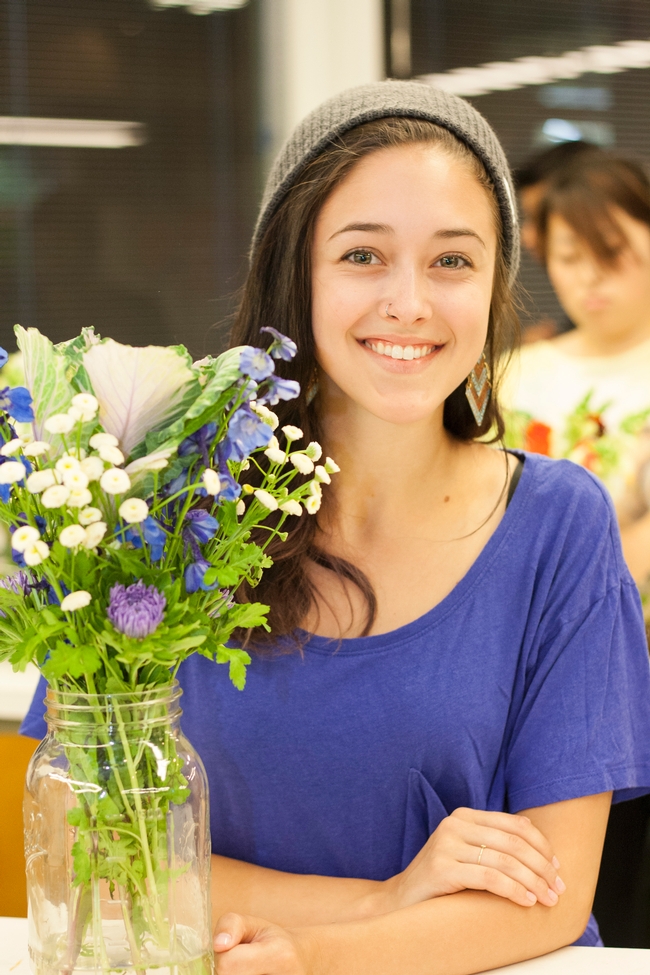At the front of the class students pluck choice flowers from a line of buckets. They trim the stems and clip the leaves, bunch a few together, arrange and rearrange them. Anthony Neve, biting his lip, places the last snapdragon in his bouquet. A graduating senior, Neve found his way into the Environmental Horticulture and Urban Forestry major and into this class as a result of his family business, Neve Brothers Wholesale Cut Flowers, which he hopes to help continue after college.
“It’s everything I’m interested in,” he admits, maintaining his focus on the ebullient bouquet before him. He lowers his head and cranes his neck, studying the arrangement from several angles. “Every day’s something new to learn.”
The course is PLS6. But the students often hear about it from its title, “Flower Power.” Professor Heiner Lieth, UC Cooperative Extension specialist in the Department of Plant Sciences at UC Davis, bills Flower Power as a fun, easy way to introduce students to a broad swath of floriculture, an industry last year worth $4 billion in U.S. sales alone, with California leading the states.
Many students, like Brinton Parker, a junior English major minoring in textiles and clothing, are drawn to the class mainly by their own curiosity. “I wanted to learn more about flowers and to satisfy my science requirement,” she says, having perfected her flower arrangement, adding: “And I kill everything I touch.”
The class begins with flower biology and societal impacts, then leads into flower colors and bouquet compatibility and delves into cut flower lifespans, transportation issues, disease management and many other topics. Lieth forces the students to rethink GMOs, he says. He shows them how the world of flowers is completely dependent on genetics and he asks them if blemishes in organic flowers are actually important to the untrained eye. The idea is to switch up the routine and always “throw something at the students they cannot possibly expect.”
Today they are working on the art of flower arrangement. It’s a special workshop the teaching staff has put together with donated flowers from industry partners. The students are applying lessons on how to strategically assemble a bouquet that graduate teaching assistant Grace Lin demonstrated at the start of the class.
“It begins well be
For Heiner Lieth, Flower Power is a teaching experiment that began three years ago. Inspired by Professor Dave Burger’s easy-going relationship with his students, Lieth wanted to provide an experience that catered towards what exactly his students wanted from a class. And to break old habits of lecture-style teaching, Lieth approached his new class as if he were offering the students a money-back guarantee. He calls it client-based teaching.
“They want a general purpose, nice and easy course, two units, general ed., science, writing, math,” undergraduate adviser Theresa Costa told Lieth when he was exploring ideas for the class. “They want it to fill their calendars.”
He came up with an introductory-level course and a title that would on its own seduce students into joining the course: “Flower Power: the Art and Science of the Beauty and Perfection of Flowers.” Quickly word-of-mouth spread and now, in the most recent quarter, the class was full within 48 hours. And, once he raised the cutoff to 190 students, it immediately filled again. “It’s extremely magnetic for students,” Lieth says.
The course is easy, he says, only in the sense that students will pass if they show up and do the work – though the workload is enough to keep them busy the entire term. And when this class finishes their flower arrangement workshop, they take their bouquets home, along with an intimate knowledge of an industry that few on campus have had the opportunity to sample.
See more Flower Power photos at the Department of Plant Sciences Facebook page here.